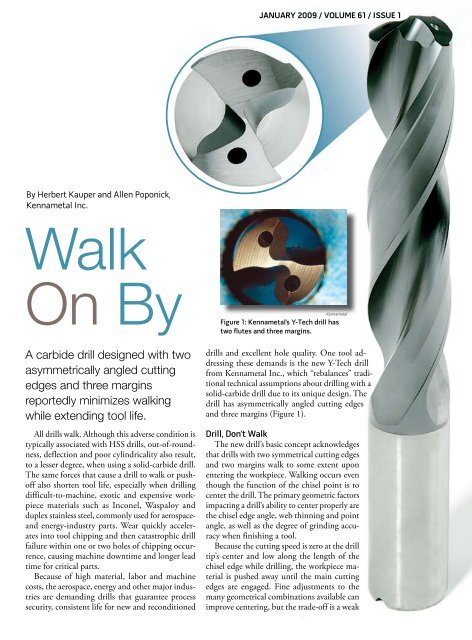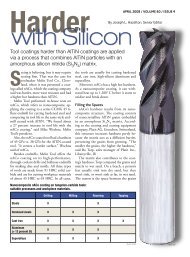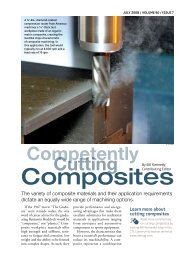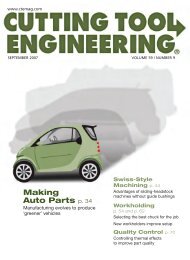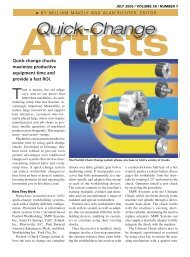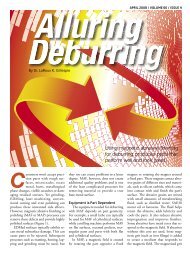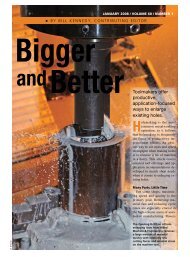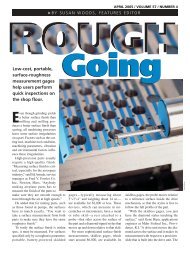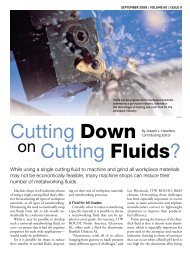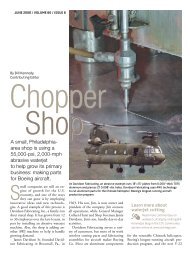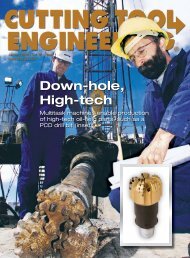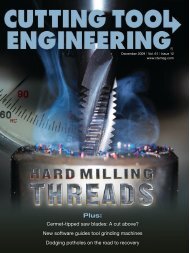A carbide drill designed with two asymmetrically angled cutting ...
A carbide drill designed with two asymmetrically angled cutting ...
A carbide drill designed with two asymmetrically angled cutting ...
You also want an ePaper? Increase the reach of your titles
YUMPU automatically turns print PDFs into web optimized ePapers that Google loves.
By Herbert Kauper and Allen Poponick,<br />
Kennametal Inc.<br />
Walk<br />
On By<br />
A <strong>carbide</strong> <strong>drill</strong> <strong>designed</strong> <strong>with</strong> <strong>two</strong><br />
<strong>asymmetrically</strong> <strong>angled</strong> <strong>cutting</strong><br />
edges and three margins<br />
reportedly minimizes walking<br />
while extending tool life.<br />
All <strong>drill</strong>s walk. Although this adverse condition is<br />
typically associated <strong>with</strong> HSS <strong>drill</strong>s, out-of-roundness,<br />
deflection and poor cylindricality also result,<br />
to a lesser degree, when using a solid-<strong>carbide</strong> <strong>drill</strong>.<br />
The same forces that cause a <strong>drill</strong> to walk or pushoff<br />
also shorten tool life, especially when <strong>drill</strong>ing<br />
difficult-to-machine, exotic and expensive workpiece<br />
materials such as Inconel, Waspaloy and<br />
duplex stainless steel, commonly used for aerospace-<br />
and energy-industry parts. Wear quickly accelerates<br />
into tool chipping and then catastrophic <strong>drill</strong><br />
failure <strong>with</strong>in one or <strong>two</strong> holes of chipping occurrence,<br />
causing machine downtime and longer lead<br />
time for critical parts.<br />
Because of high material, labor and machine<br />
costs, the aerospace, energy and other major industries<br />
are demanding <strong>drill</strong>s that guarantee process<br />
security, consistent life for new and reconditioned<br />
JANUARY 2009 / VOLUME 61 / ISSUE 1<br />
Kennametal<br />
Figure 1: Kennametal’s Y-Tech <strong>drill</strong> has<br />
<strong>two</strong> flutes and three margins.<br />
<strong>drill</strong>s and excellent hole quality. One tool addressing<br />
these demands is the new Y-Tech <strong>drill</strong><br />
from Kennametal Inc., which “rebalances” traditional<br />
technical assumptions about <strong>drill</strong>ing <strong>with</strong> a<br />
solid-<strong>carbide</strong> <strong>drill</strong> due to its unique design. The<br />
<strong>drill</strong> has <strong>asymmetrically</strong> <strong>angled</strong> <strong>cutting</strong> edges<br />
and three margins (Figure 1).<br />
Drill, Don’t Walk<br />
The new <strong>drill</strong>’s basic concept acknowledges<br />
that <strong>drill</strong>s <strong>with</strong> <strong>two</strong> symmetrical <strong>cutting</strong> edges<br />
and <strong>two</strong> margins walk to some extent upon<br />
entering the workpiece. Walking occurs even<br />
though the function of the chisel point is to<br />
center the <strong>drill</strong>. The primary geometric factors<br />
impacting a <strong>drill</strong>’s ability to center properly are<br />
the chisel edge angle, web thinning and point<br />
angle, as well as the degree of grinding accuracy<br />
when finishing a tool.<br />
Because the <strong>cutting</strong> speed is zero at the <strong>drill</strong><br />
tip’s center and low along the length of the<br />
chisel edge while <strong>drill</strong>ing, the workpiece material<br />
is pushed away until the main <strong>cutting</strong><br />
edges are engaged. Fine adjustments to the<br />
many geometrical combinations available can<br />
improve centering, but the trade-off is a weak
chisel edge. Conversely, a robust chisel<br />
edge produces poor centering and high<br />
thrust but can tolerate high feed rates.<br />
Recent studies by the Institut für<br />
Produktionsmanagement, Technologie<br />
und Werkzeugmaschinen Technische<br />
(PTW), Universität Darmstadt, Germany,<br />
showed that as the chisel edge enters<br />
a workpiece, it creates a concave oval.<br />
This causes the <strong>drill</strong> to “swing” in a motion<br />
similar to a pendulum (Figures 2a<br />
and 2b). For ease of description, the <strong>drill</strong><br />
creates a triangular hole; the corners of<br />
the <strong>drill</strong> form the triangle’s points as the<br />
<strong>drill</strong> continues the pendulum motion<br />
created by the chisel edge.<br />
Coupled <strong>with</strong> the feed rate, the <strong>cutting</strong><br />
action is slightly comparable to helical<br />
interpolation, <strong>with</strong> the <strong>drill</strong> margins<br />
typically riding the lead of the chisel edge<br />
throughout the hole. The result is an outof-round<br />
hole <strong>with</strong> poor cylindricality<br />
and, at times, notable deflection from<br />
the centerline.<br />
Cutting forces are not equal per <strong>cutting</strong><br />
edge, so each <strong>cutting</strong> edge is at a<br />
slightly different plane as it follows the<br />
PTW<br />
Figures 2a and 2b: These illustrations show the pendulum motion and its impact on hole<br />
roundness caused by the concave oval that’s created as a conventional <strong>drill</strong>’s chisel edge<br />
enters a workpiece.<br />
pendulum. Geometric deviations found<br />
in the <strong>drill</strong> grinding process, such as unequal<br />
hones on the <strong>cutting</strong> edges and<br />
symmetry errors, also contribute to creating<br />
asymmetric <strong>cutting</strong> forces.<br />
Material Matters<br />
High-tensile-strength workpiece materials<br />
compound the issues previously<br />
noted. However, the aerospace, energy,<br />
food processing and medical industries<br />
desire parts made of those materials.<br />
When machining these materials, machine<br />
operators must lower feed rates,<br />
extending the time a <strong>drill</strong>’s chisel edge is<br />
pushing material away before the main<br />
<strong>cutting</strong> edges engage the workpiece. Such<br />
extreme wear on the chisel edge further
Walk On By (continued)<br />
reduces a <strong>drill</strong>’s ability to center for subsequent<br />
holes, thereby increasing the pendulum<br />
motion.<br />
Workhardening and elasticity increase<br />
<strong>cutting</strong> forces and therefore the<br />
risk of <strong>drill</strong> push-off when <strong>drill</strong>ing hightensile-strength<br />
materials. As a result,<br />
hole-roundness errors become more pronounced<br />
in these materials.<br />
Typical tool wear when <strong>drill</strong>ing these<br />
materials includes chipping of the chisel<br />
edge, <strong>cutting</strong> edge (often caused as the<br />
<strong>drill</strong> is retracted) and the margin below<br />
the <strong>cutting</strong> edge. All contribute to reducing<br />
the number of times a <strong>drill</strong> can<br />
be reground, reducing <strong>drill</strong> life and the<br />
tool’s overall value.<br />
Other factors affecting hole quality are<br />
toolholding, machine rigidity and fixturing.<br />
However, these factors can rarely rectify<br />
errors starting at the chisel edge.<br />
Reconsidering Balance<br />
Balance is a state of equilibrium. Although<br />
symmetrically <strong>designed</strong>, conventional<br />
<strong>drill</strong>s tend to create and perpetuate<br />
Kennametal<br />
A chipped margin land, such as the one<br />
shown on this conventional solid-<strong>carbide</strong><br />
<strong>drill</strong>, reduces the number of times a solid<strong>carbide</strong><br />
<strong>drill</strong> can be reground.<br />
unbalanced <strong>cutting</strong> forces in the cut that<br />
cannot be controlled. The Y-Tech <strong>drill</strong><br />
redefines balance from an aesthetic design<br />
to a controlled function of the <strong>drill</strong>ing<br />
process.<br />
The new <strong>drill</strong>’s design is not symmetrical.<br />
One of the <strong>two</strong> <strong>cutting</strong> edges is<br />
<strong>asymmetrically</strong> <strong>angled</strong> above the <strong>drill</strong>’s<br />
centerline. This slightly leading edge<br />
creates an overriding, one-directional<br />
force.<br />
Counteracting this force is a guiding<br />
margin behind the lead <strong>cutting</strong> edge.<br />
This controlled <strong>cutting</strong> force is directed<br />
against the guiding margin counterforce,
Glossary<br />
The following Terms were extracted from ANSI B94.11-M-1979, “Twist Drills—<br />
Straight Shank and Taper Shank, Combined Drills and Countersinks.”<br />
chisel edge<br />
Edge at the end of the web that<br />
connects the <strong>cutting</strong> lips.<br />
chisel edge angle<br />
Angle included between the chisel edge<br />
and the <strong>cutting</strong> lip as viewed from the<br />
end of the <strong>drill</strong>.<br />
lips<br />
Cutting edges of a 2-flute <strong>drill</strong> that<br />
extend from the chisel edge to the<br />
periphery. On core <strong>drill</strong>s, the lips are<br />
the <strong>cutting</strong> edges that extend from the<br />
bottom of the chamfer to the periphery.<br />
margin<br />
Cylindrical portion of the land that is<br />
not cut away to provide clearance.<br />
ensuring the <strong>drill</strong> maintains the tool’s diameter<br />
throughout the cut. Any latent<br />
side-to-side forces are supported by <strong>two</strong><br />
traditionally placed margins.<br />
To minimize the walking and pendulum<br />
motion, the new <strong>drill</strong> has a chisel<br />
edge that enables effective self-centering<br />
and a relatively short transition time<br />
from the chisel to the <strong>cutting</strong> edges. In<br />
addition, the <strong>drill</strong> is suited for the low<br />
feed rates generally used in <strong>drill</strong>ing hightemperature<br />
alloys because the <strong>cutting</strong><br />
edges have a light or medium hone that<br />
ensures the <strong>drill</strong> is <strong>cutting</strong> <strong>with</strong>out workhardening.<br />
Eliminating the pendulum motion<br />
not only improves hole quality but also<br />
reduces wear on the chisel edge, <strong>cutting</strong><br />
lips and the corner of the <strong>drill</strong>, substantially<br />
improving tool life. A producer of<br />
power turbines made from ASTM A 681<br />
D3 (DIN X210Cr12) material reported a<br />
60 percent improvement in tool life and<br />
elimination of retraction damage caused<br />
point<br />
Cutting end of the <strong>drill</strong>, comprised of<br />
the ends of the lands, the web and the<br />
lips. It resembles a cone, but it departs<br />
from a true cone to furnish clearance<br />
behind the <strong>cutting</strong> lips.<br />
point angle<br />
Angle included between the lips<br />
projected upon a plane parallel to the<br />
<strong>drill</strong> axis and parallel to the <strong>cutting</strong> lips.<br />
web thinning<br />
Operation of reducing the web<br />
thickness at the point to reduce <strong>drill</strong>ing<br />
thrust.<br />
Comparison of <strong>drill</strong> performance when <strong>drill</strong>ing duplex stainless steel<br />
in a laboratory test.<br />
Y-Tech <strong>drill</strong> Conventional solid-<strong>carbide</strong> <strong>drill</strong><br />
Roundness 13µm 52µm<br />
Cylindricality 19µm 117µm<br />
Straightness 20µm 23µm<br />
Parallelism 20µm 36µm<br />
Inclination 4µm 33µm<br />
Kennametal<br />
by hole shape errors, such as spirals and<br />
corner chipping.<br />
Drills want to walk when entering a<br />
workpiece, but <strong>drill</strong>s that rebalance traditional<br />
technical assumptions can provide<br />
improved hole quality required for<br />
critical parts. CTE<br />
About the Authors: Herbert Kauper is<br />
senior product engineer, solid-<strong>carbide</strong><br />
<strong>drill</strong>s, and Allen Poponick is manager,<br />
global machine technology-holemaking<br />
for Kennametal GmbH & Co. KG, Fürth,<br />
Germany. For more information about the<br />
company’s <strong>cutting</strong> tools, call Kennametal<br />
Inc., Latrobe, Pa., at (800) 446-7738 or visit<br />
www.kennametal.com.<br />
www.ctemag.com<br />
For more information, visit<br />
“Articles Archive Index” and select<br />
the “Holemaking” category.<br />
CUTTING TOOL ENGINEERING Magazine is protected under U.S. and international copyright laws.<br />
Before reproducing anything from this Web site, call the Copyright Clearance Center Inc. at (978) 750-8400.


